The first ever Watercolor Live presented artists around the world the opportunity to engage with and learn from the top painters working in watercolor today. With roughly 1,700 in attendance from 40 countries, the virtual event — the largest of its kind — showcased the range and diversity of effects possible with the medium. And we’re doing it again!
Join Alvaro Castagnet, Cindy Baron, and Stewart White — with many others to be named soon — for another groundbreaking global event — Watercolor Live 2022!
In case you missed it, here’s a taste of the first Watercolor Live event.
Watercolor Live Highlights: Beginner’s Day
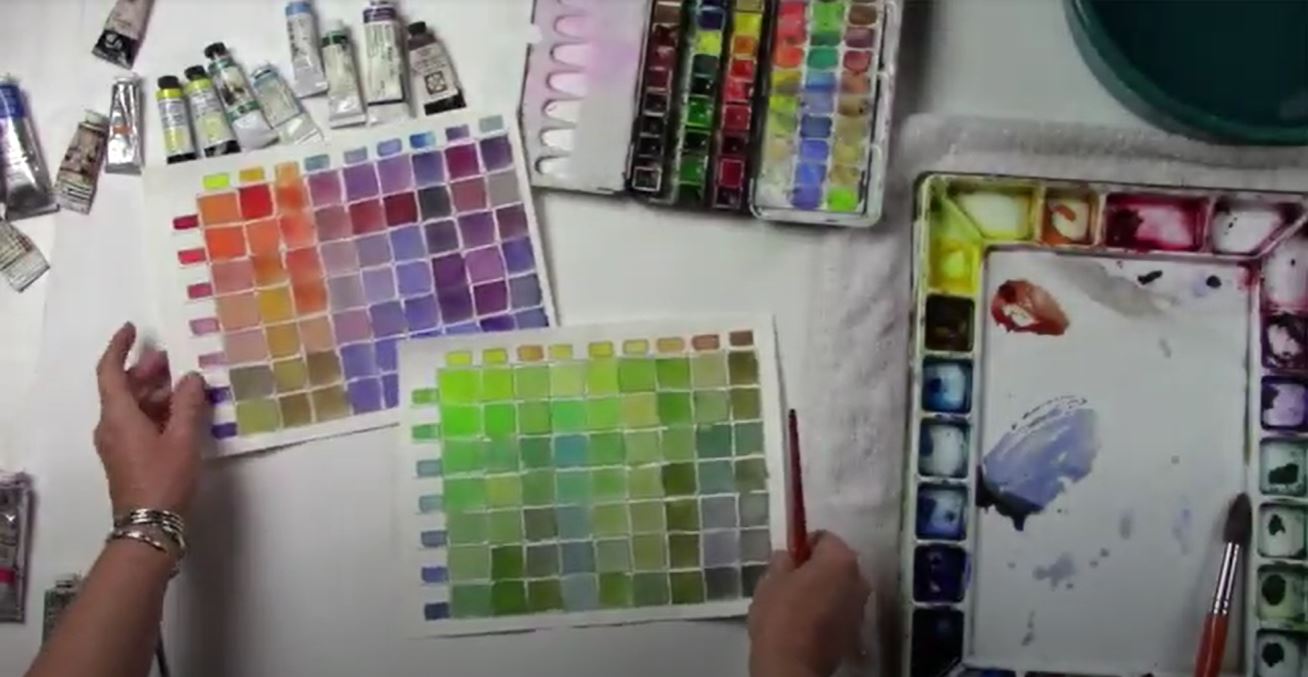
In our first presentation, “Understanding Your Materials,” Birgit O’Connor took us through everything we needed to know to get started painting with watercolor. She explained the variety of brushes, surfaces, and colors, including side-by-side differences. She advises that if you’re just starting out, it’s fine to go with more affordable student-grade materials, and later begin to invest in higher quality supplies as you gain experience.
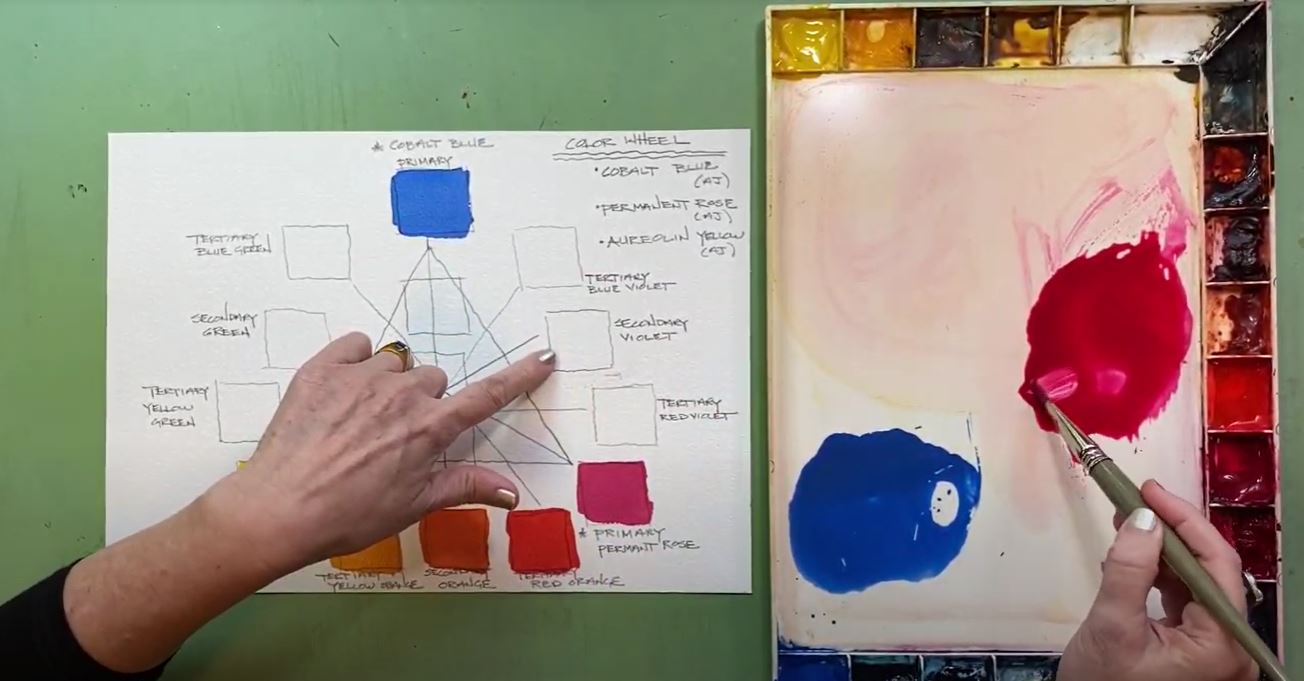
Kim Minichiello led a session titled “Color Mixing & Using a Limited Palette,” in which she explained the four basic properties of color (hue, value/tone, temperature, and intensity) and the basic principles of color theory. Kim also shared how working with primary colors and mixing your own secondary and tertiary colors can be freeing and save you the trouble of having to choose and buy more paint.
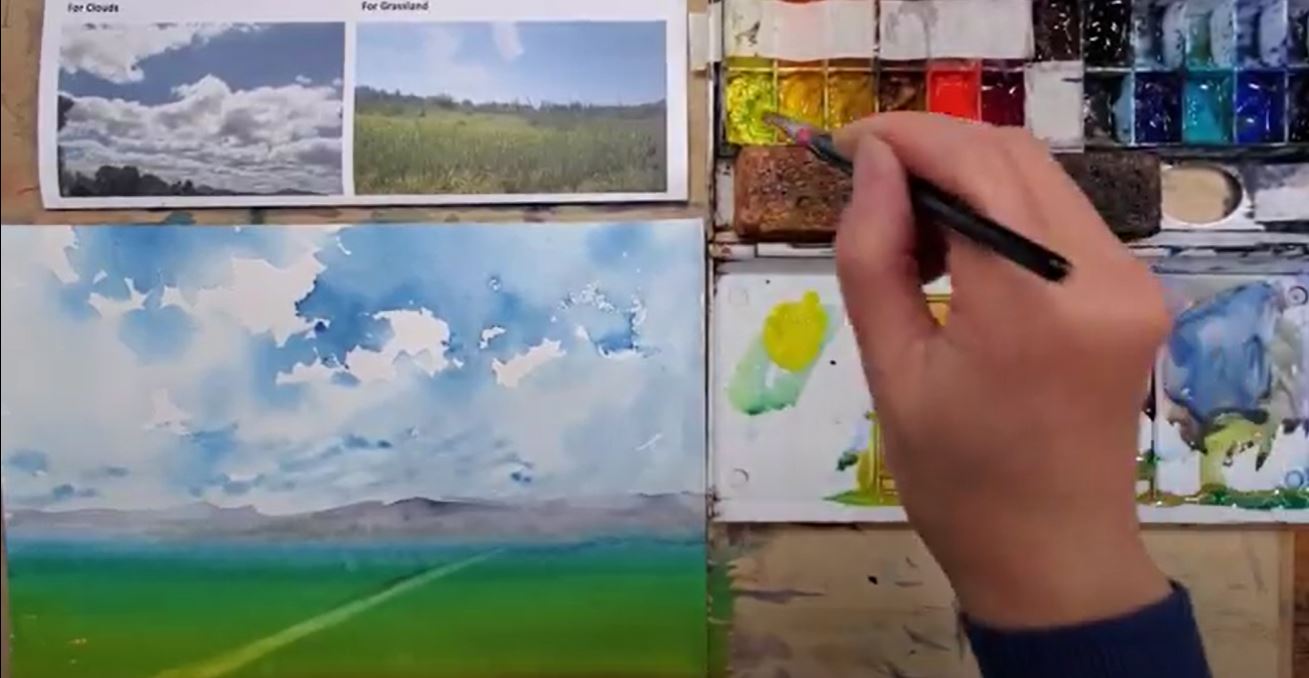
In the session “Key Watercolor Techniques for Beginners,” Shuang Li demonstrated how to create a graduated wash and variegated wash, how to make a variety of marks, how to “lift” watercolor paint from the paper, and much more.
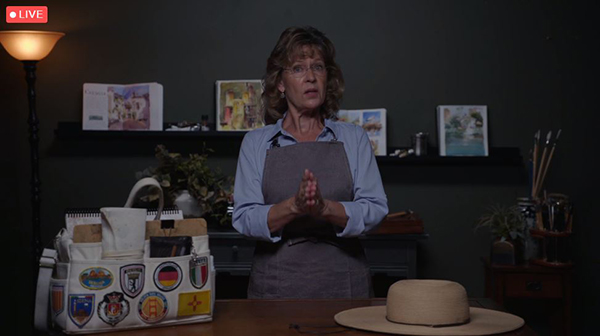
Painting is more fun with a friend! That’s one of the first tips Brenda Swenson shared in “Watercolor Sketching en Plein Air.” She went on to say that taking a friend along with you will help you remember to not take everything too seriously, and to just have fun when painting en plein air. Brenda gave general advice for those venturing out for the first time, including what gear to take, how to start with a sketch, and more. One of her helpful tips: Keep your paper on a slight angle to keep your watercolors from puddling on the page.
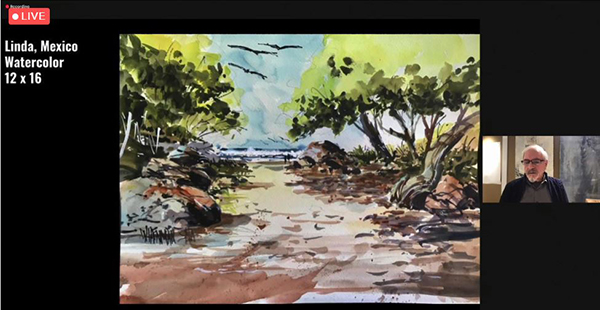
Because critiques are an important part of the experience for any workshop, American Watercolor Society President Antonio Masi walked us through the elements that judges look for when viewing a painting … mastery of technique, eye-catching work, interesting style, evidence of personality, and originality. He added, “Look more, think more, paint less.”
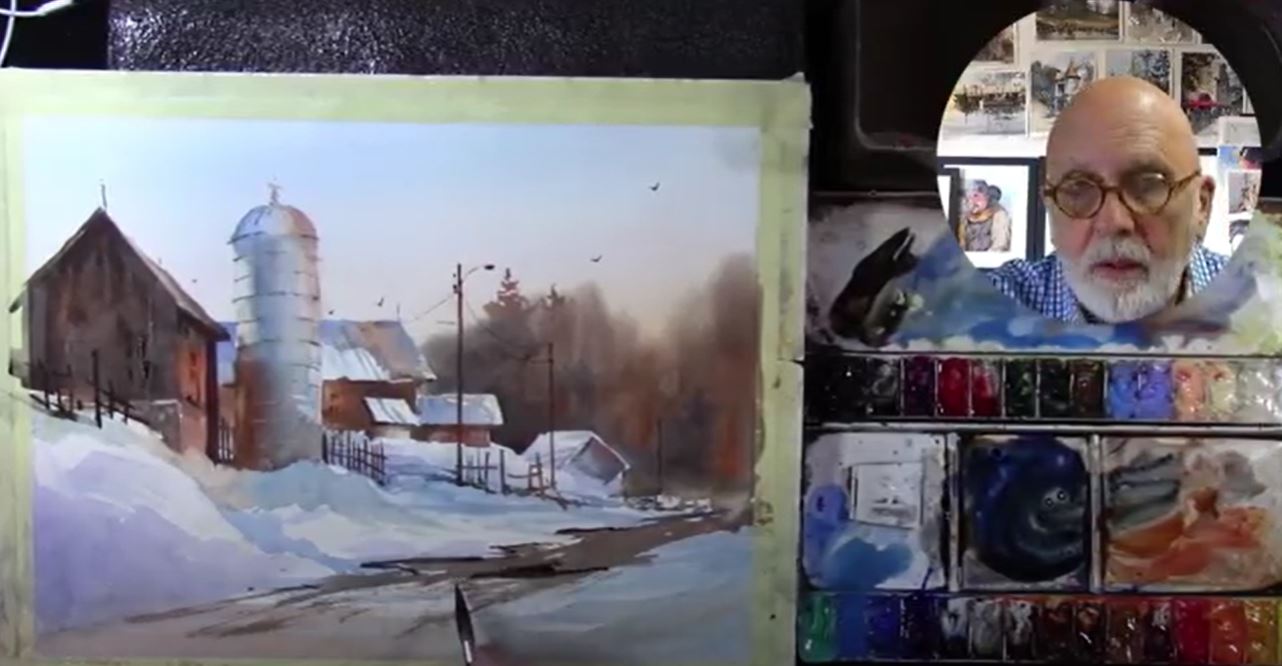
Michael Holter taught a lesson on “light” in a representational landscape painting: “Part of this process is that you want to allow the painting to develop in such a way that you are observing what’s going on, and you are making adjustments as you go … that can work with the theme you have, or the light source, or the photograph you’re working from, or if you’re in plein air, what it is you’re trying to accomplish.”
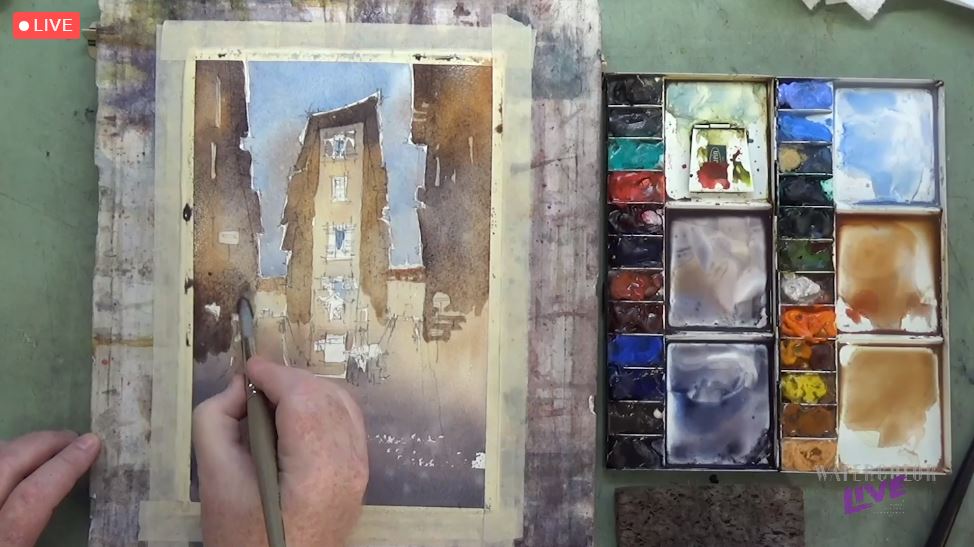
We rounded out Beginner’s Day with Iain Stewart’s “(Staying Loose While) Working From Photos” demonstration, in which he explained how to simplify your photo reference, the importance of establishing the eye level and looking for big shapes, how he uses “the keyhole” to unlock the best composition for a busy city scene, and much more. Iain even shared a bonus tip at the beginning of the day for everyone: “When you are viewing actual painting demos remember to watch what is happening in the palette as much as what’s happening on paper. Look for the thickness of paint as well as the colors used.”
We ended the day with the popular Virtual Happy Hour and Paint Along session, during which attendees painted from a photo reference of the Grand Canyon.
Watercolor Live Highlights: Day 1
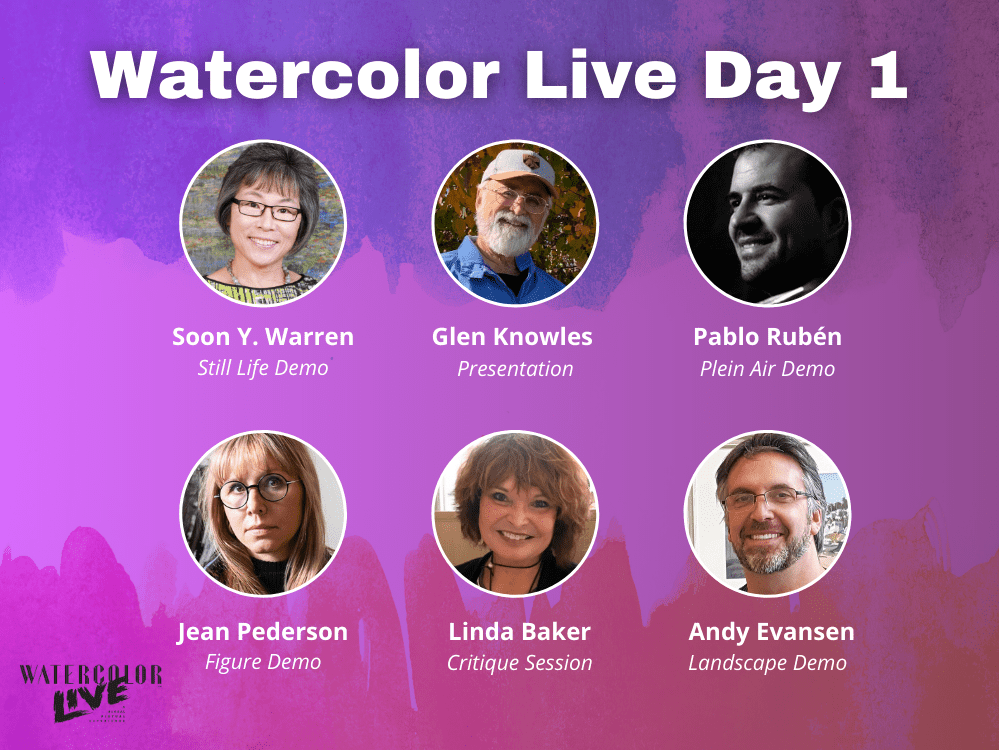
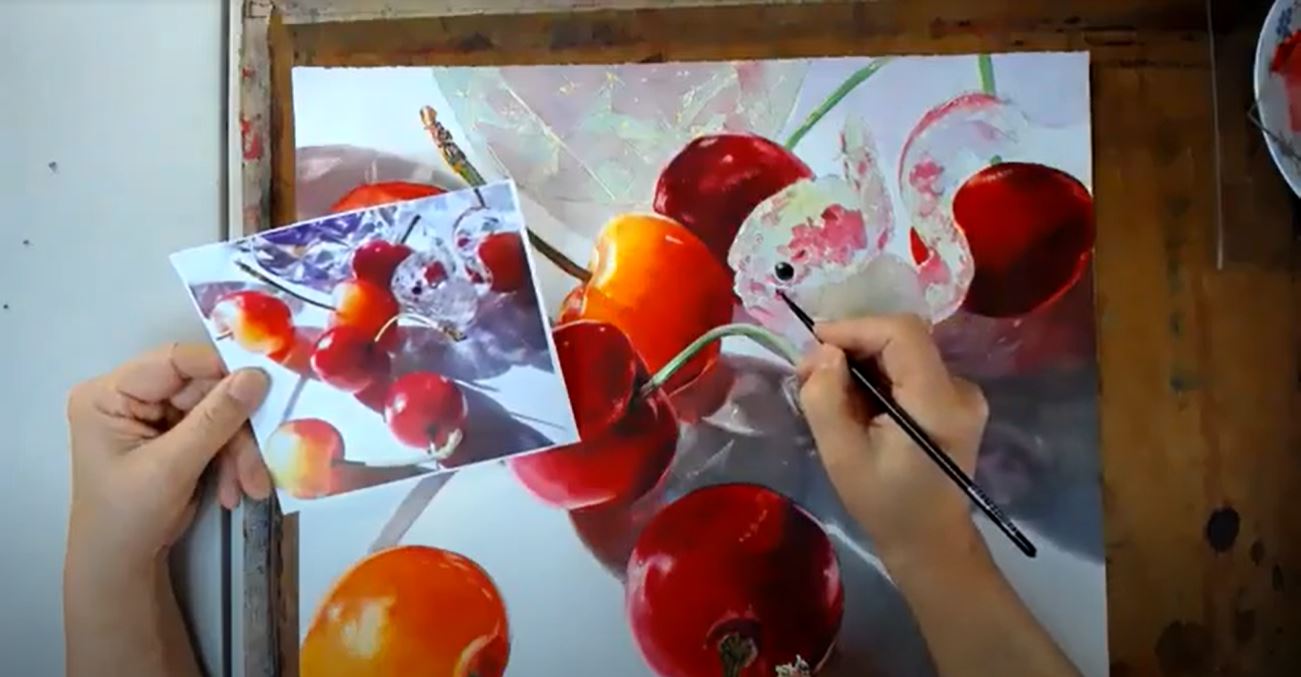
Using a photo reference, Soon Warren demonstrated how to create a large, vibrant watercolor still life painting of cherries, and answered many questions about her techniques during the live chat session.
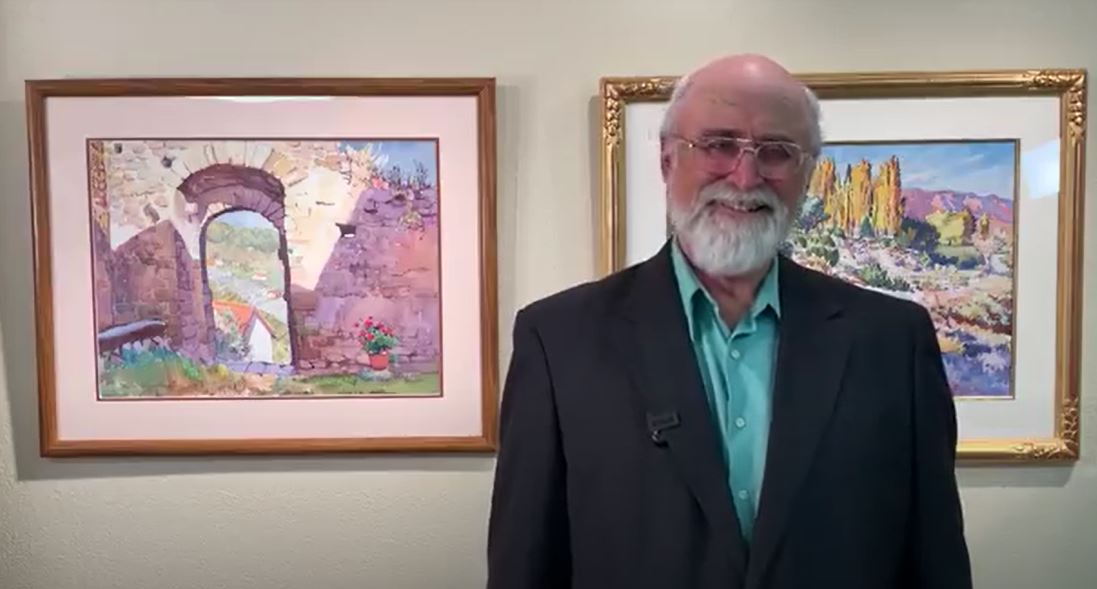
We enjoyed an insightful presentation from artist and curator Glen Knowles, who shared stories, lessons, and more from his life in art. Said one attendee: “Wow! My world is getting expanded in a big wonderful way!”
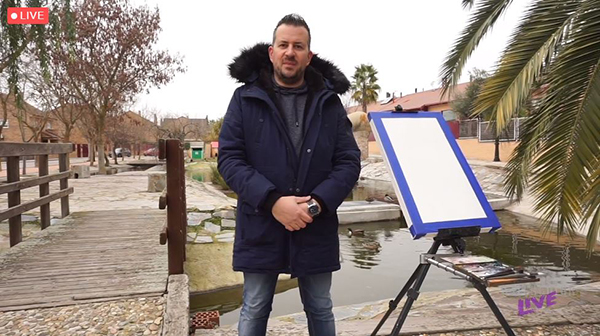
Coming to us all the way from Madrid, Spain, Pablo Rubén set up at a quaint waterway for a plein air demonstration. To begin, he demonstrated the basics such as how his aluminum field easel works with varying angles, the properties of his paper (300# Arches), his support and brass palette, and his Escoda brushes. Throughout his painting demo, Pablo used an old credit card to scrape excess water from the paper.
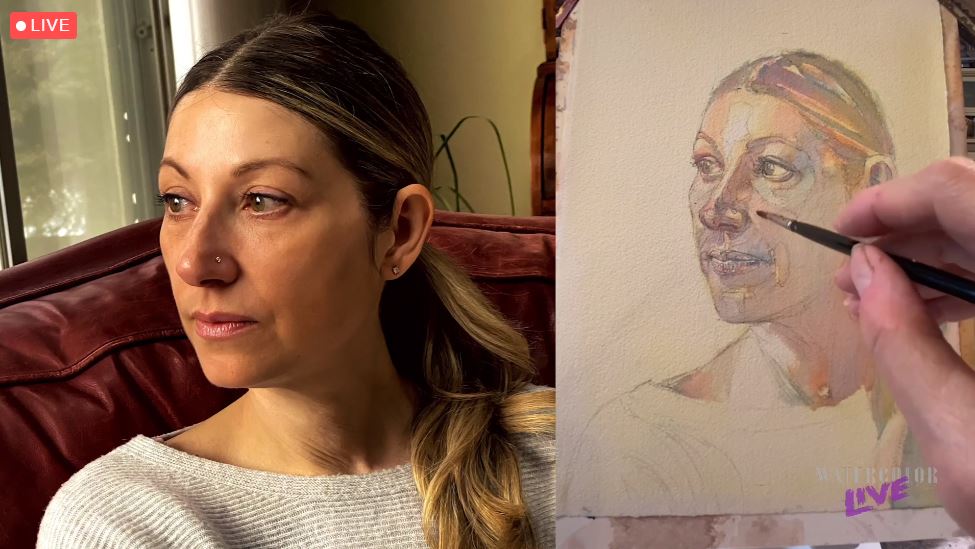
Jean Pederson‘s traditional practice includes referential imagery of people, still life, landscape, and abstraction. The layering of a variety of media offers her an assortment of possibilities within her work; quality of edge, line, and texture all play a role within her imagery. Jean gave a demo on painting a portrait of a model using a reference photo, creating a luminous painting before our eyes.
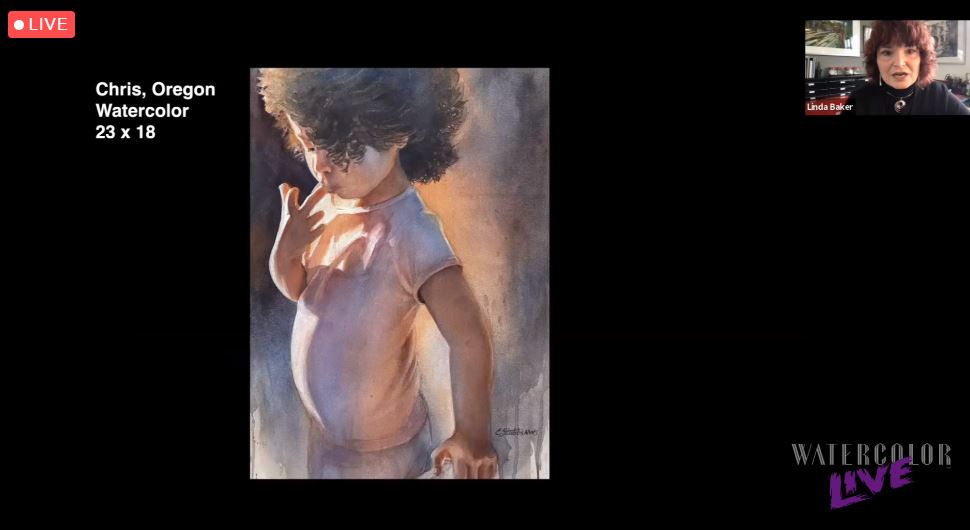
With more than 200 entries to choose from, Linda Daly Baker gave insightful critiques on a variety of paintings submitted by attendees. She focused on elements of composition and design, pointing out that no matter your subject or medium, these two elements can make or break a painting.
Bonus tip: She said our eyes are naturally distracted by text in a painting, so if you have a sign in the background, it’s good to soften the text so the viewer can focus on your intended focal point.
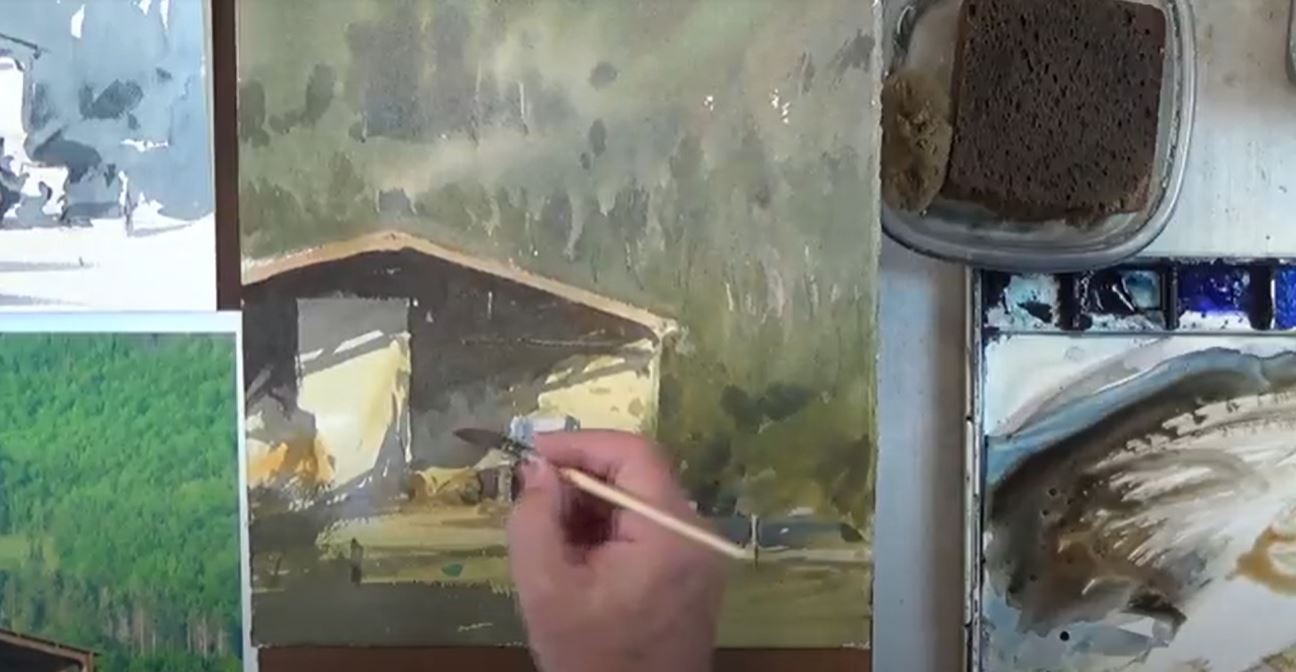
While finishing a watercolor he started during a workshop he was teaching in France, AndyEvansen explained how to think more about value (not just color) in his demo. Andy said that Payne’s Grey is a cool dark that works well for his value studies, and shared insights on the initial drawing stages: “If I know a shape is going to be dark later, I’ll go ahead and darken the pencil drawing so it doesn’t get lost later…there’s no point in doing a nice drawing if it’s going to disappear after a light wash of paint.”
We rounded out the day with a Virtual Cocktail Hour and Paint Along Session that featured a still life setup.
Watercolor Live Highlights: Day 2
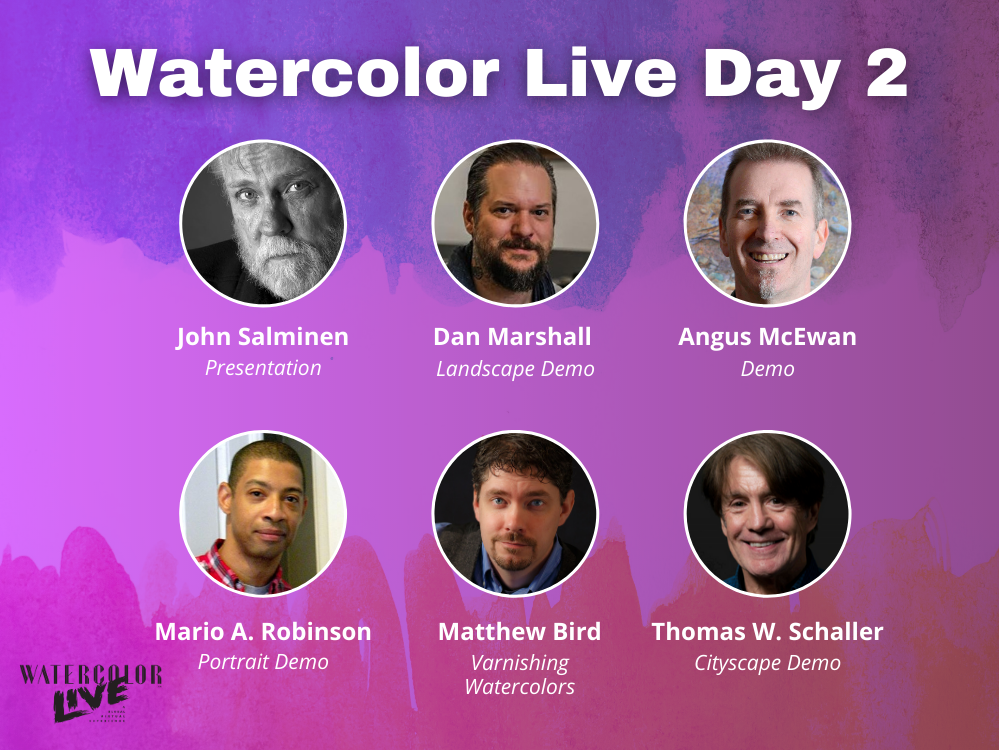
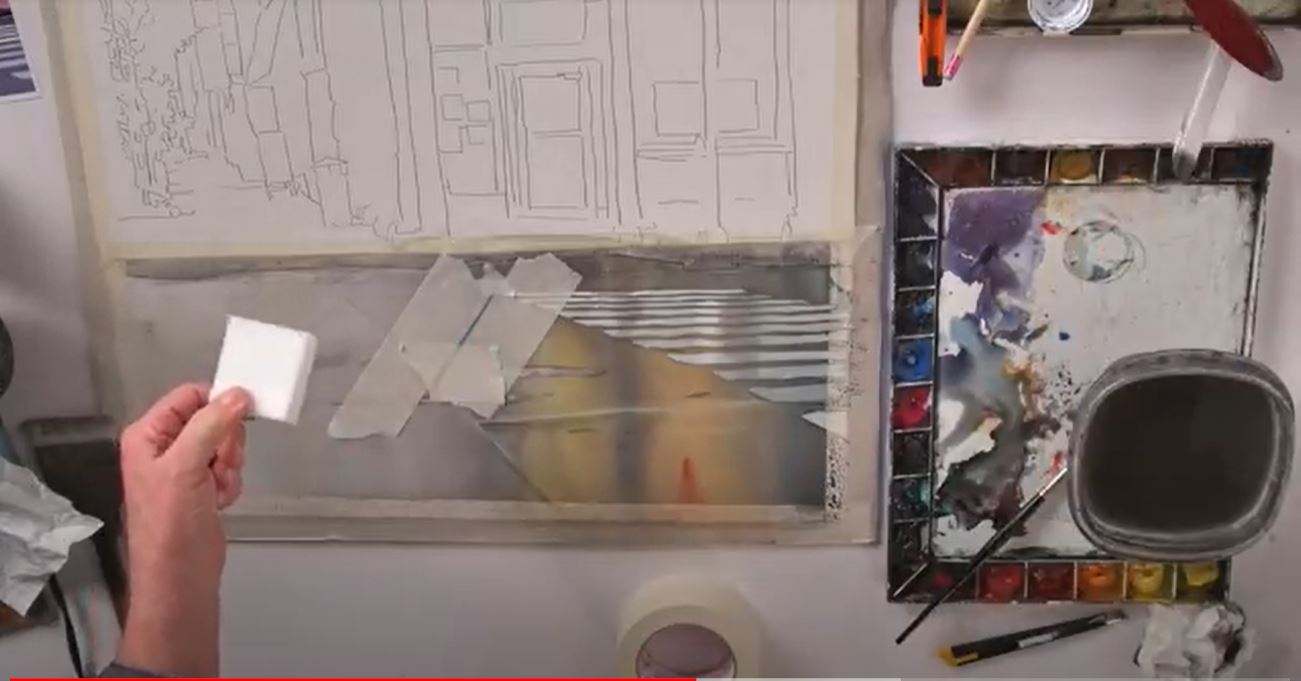
John Salminen’s painting demo featured a wet, reflective street, with a technique that was “applicable to any situation where you need to infuse a warm, luminous glow onto the surface of the painting.” Shown: Salminen explains how he uses a magic eraser (and more tools!) for his watercolor scene.
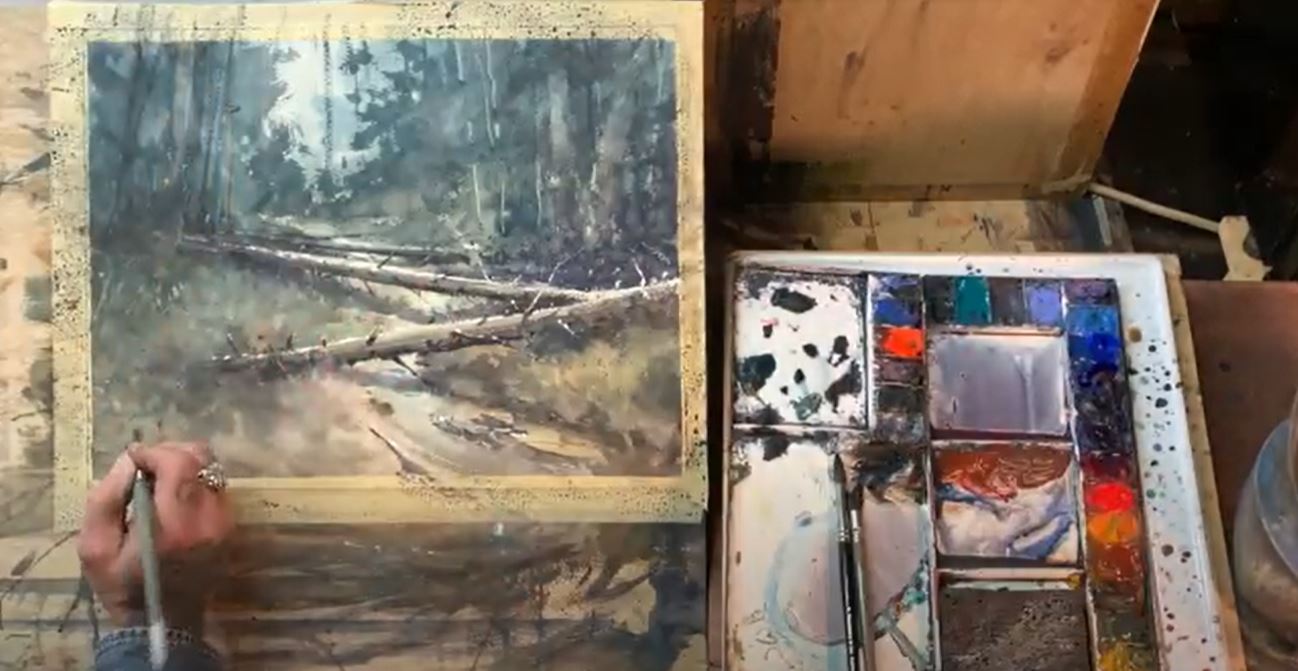
From his studio in Denver, Colorado (with a special field trip for the initial study), Dan Marshall taught us how to paint a well-designed landscape in watercolor. It can be challenging to start with a busy scene, so Dan explained how he works through a painting that’s overloaded with detail, allowing you to effectively tell a story through the composition.
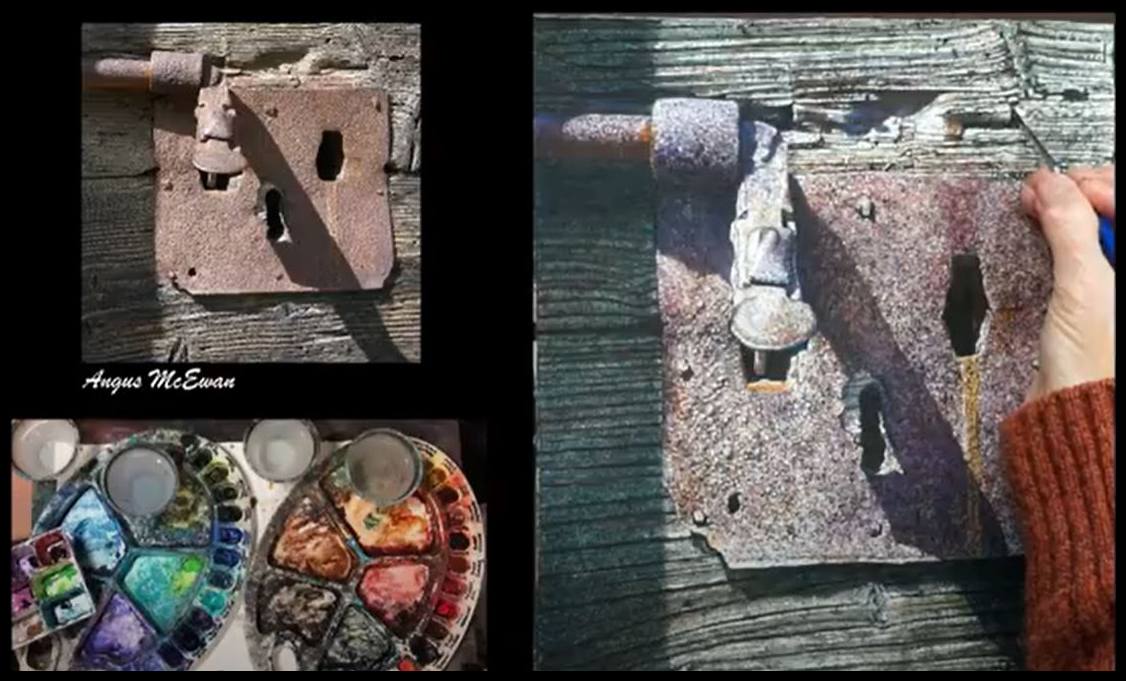
Angus McEwan, an artist from Scotland, walked us through his process for painting rust. Inspired by an old door he came across while in Venice, Angus began his composition with a light, simplified drawing. He told us he prefers short handled brushes, which he finds easier to control; and for this demo, he painted on handmade Fabriano paper (28.5 x 28.5 cm).
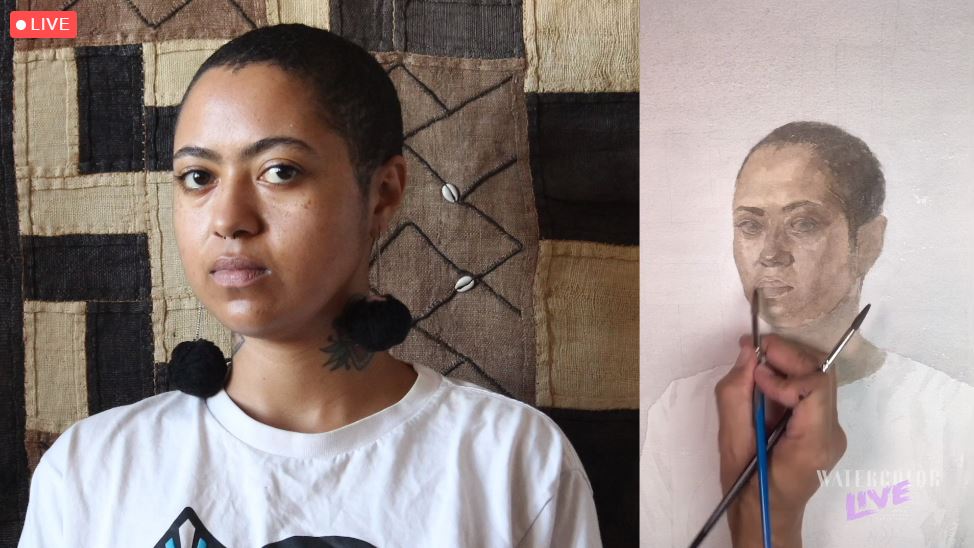
In another anticipated portrait demo, Mario A. Robinson used a monochromatic block-in method to push his colors back and make them look more realistic (Note: He used burnt umber and ultramarine blue to start with the eyes). If you’re struggling with watercolor, rest assured; he advised that “Watercolor takes a lot of time to maintain a comfort level with the medium.”
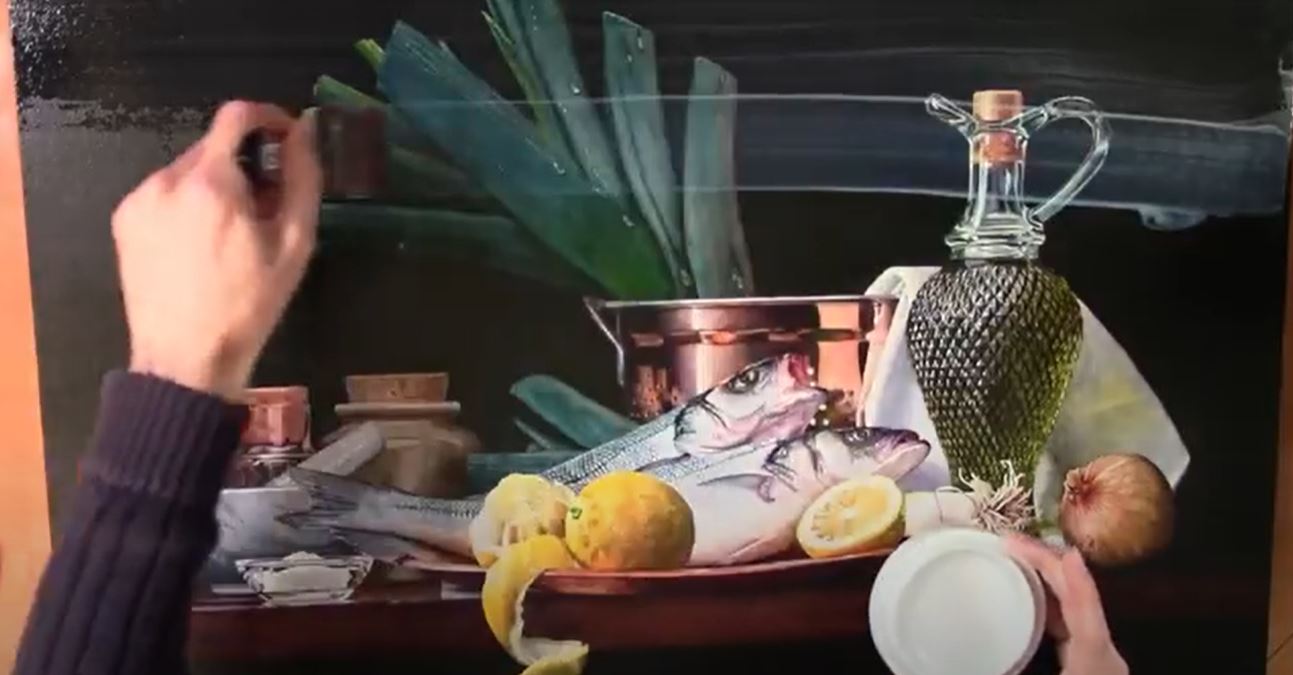
In his demonstration, Matthew Bird admitted he’s a renegade when it comes to certain watercolor practices. He showed us how he varnishes and frames his paintings. Bonus Tip: He said to use something like rolls of masking tape (Matthew uses ceramic mixing cups) that can elevate the panel the inch or so off the table, so you can brush the varnish right past the edge, without touching your brush to the table surface.
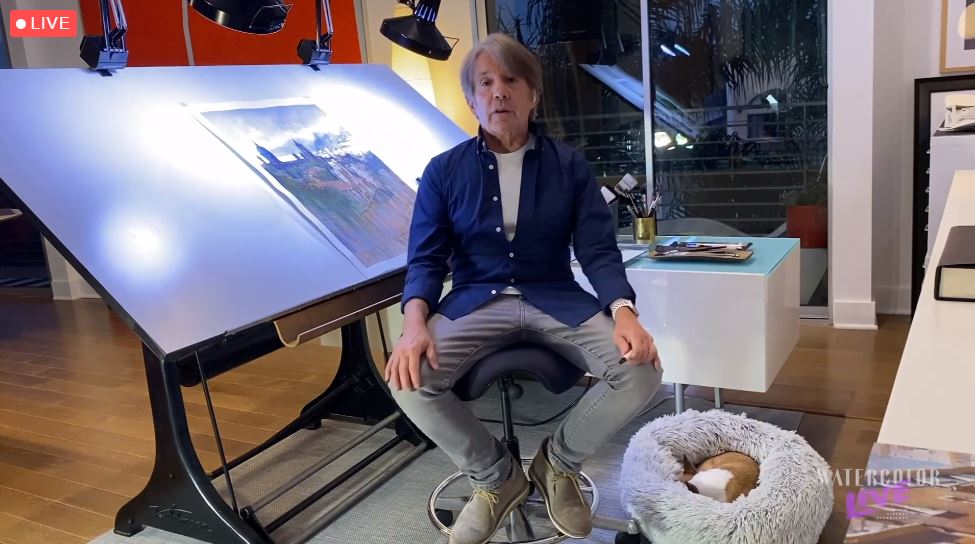
From his home studio, Thomas Schaller led us through a watercolor demonstration of an imaginary city view. He typically builds his paintings up from light to dark, and showed us how each step of the way. Thomas also explained how his goal was to become an artist with recognizable style; to do so, he uses existing painting and design tools to make art that’s “as uniquely mine as possible.” A side note: Yes, many of us experienced “drafting desk envy.”
Watercolor Live Highlights: Day 3
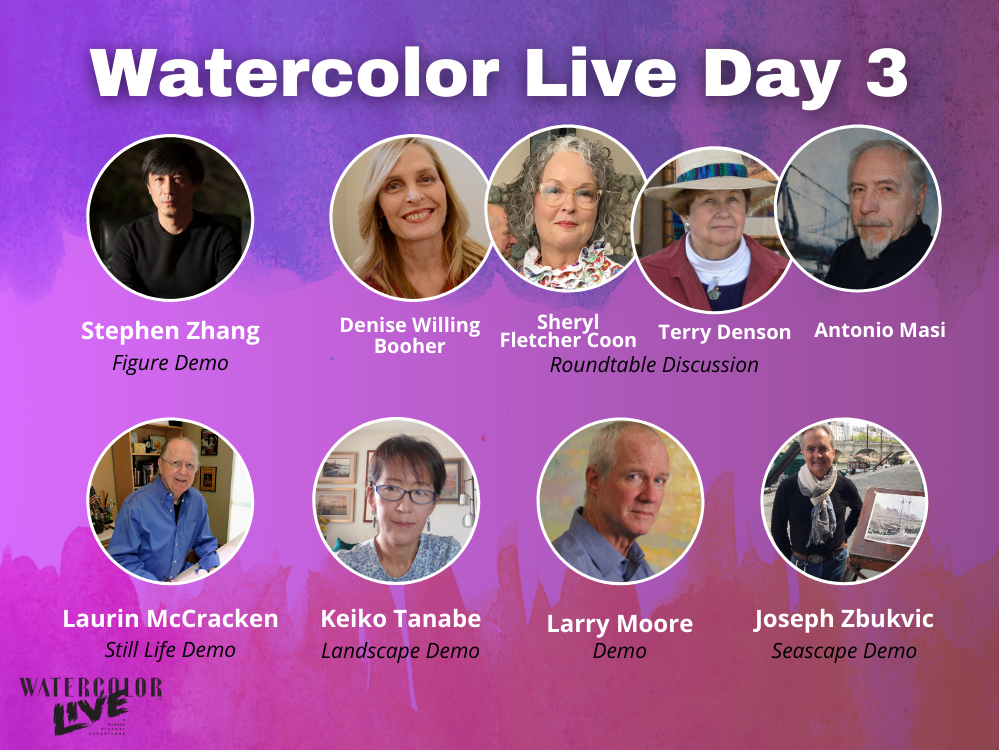
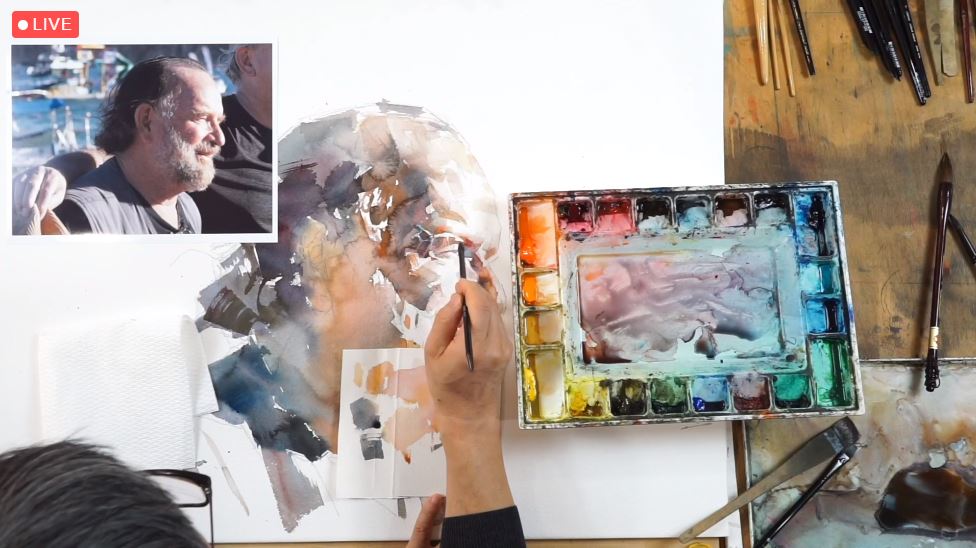
Stephen Zhang incorporates artistic traditions from the East and West. In his demo, he took us through his variety of supplies (Hint: he uses M. Graham and Rembrandt paints) and his decision-making process as he created a portrait of a Vietnam Veteran. Stephen’s advice: Don’t be too critical as you paint.
Kelly Kane hosted an engaging roundtable discussion with representatives from AWS, NWS, TWSA, and FWS. Denise Willing Booher, Sheryl Fletcher Coon, Terry Denson, and Antonio Masi shared their thoughts on the hot topics watercolorists face today.
They began the talk by addressing the underrepresentation of watercolor art at museums and the discrepancy in price points compared to oil paintings, for example. Attendees actively shared their comments in the live chat, adding to the conversation at large.
The topics also included what watercolor societies are doing to promote the medium, trends in today’s watercolor art, and what the future looks like for watercolor.
Realist painter Laurin McCracken gave a still life demo on 300# soft pressed paper, which has more “shallow valleys” for the paint. Laurin shared how he uses a batiking tool (intended for fabric arts) to transfer clean water to his palette. Why? Because it gives him enough control to add just a single tiny dot of water, if that’s what he needs at the moment.
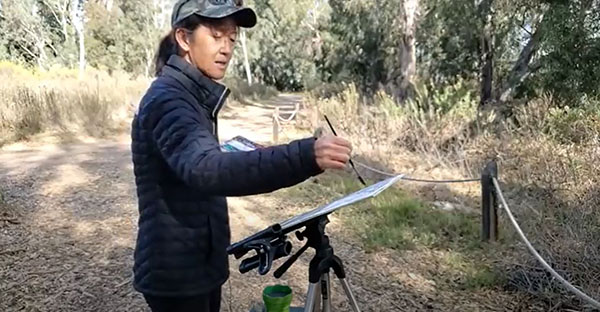
Keiko Tanabe, who filmed her session from San Diego, California, demonstrated how to capture a quick landscape en plein air with watercolor. Tanabe showed us how she “scans a scene” and considers both the foreground and background to determine her subject matter and composition.
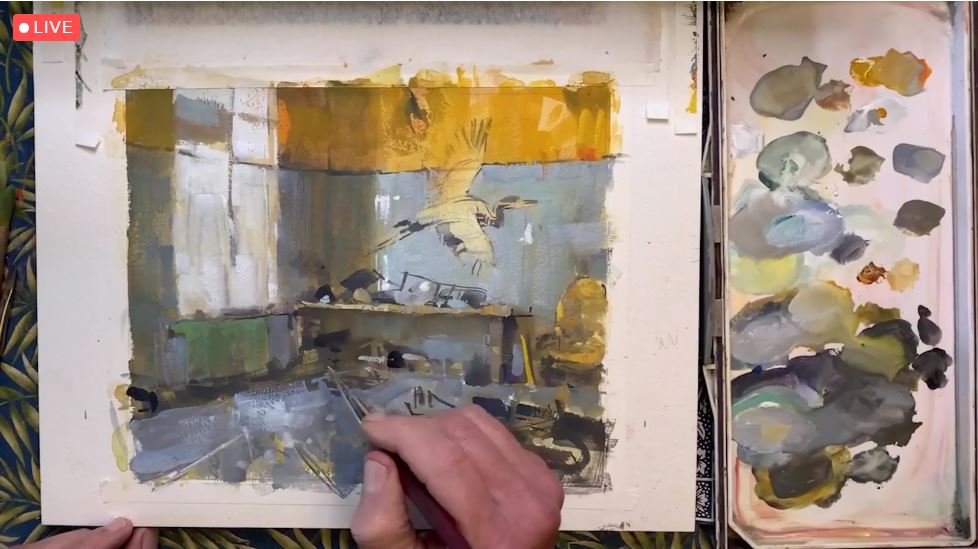
Artist and author Larry Moore led a demonstration using gouache, a “super versatile” medium. “I don’t know if it’s THE process, but it’s mine,” he said. Larry’s creative composition included a heron in flight through a dilapidated building. He added, “If you just let gouache do its job, it practically paints itself.”
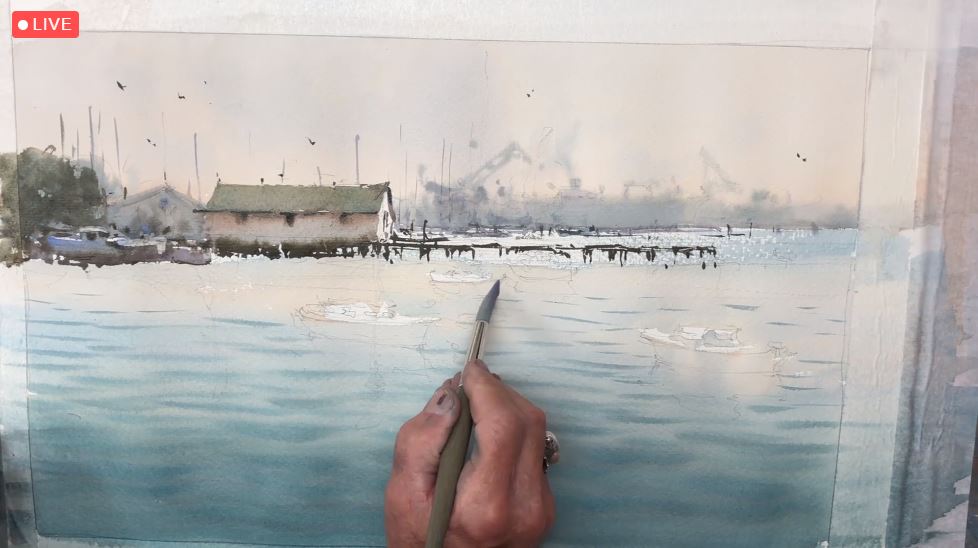
Last but certainly not least, Joseph Zbukvic took us on an intimate tour of his studio before starting his tonal seascape demo. “I’m a tonalist, not a colorist,” he said. Fellow faculty instructor Laurin McCracken said, “You have not lived until you have stood next to Joseph while he paints on the seashore in China. The constant flurry of activity, back by years of practice, unfolds in front of you, brush stroke by brush stroke, into magic.” After watching this demo, we believe it!
Of course, we rounded out the day – and the event – with a final Paint-Along session in the Virtual Studio and a Happy Hour in a Zoom call with a few hundred of our closest watercolor friends.
Be sure to join us for Watercolor Live 2022!

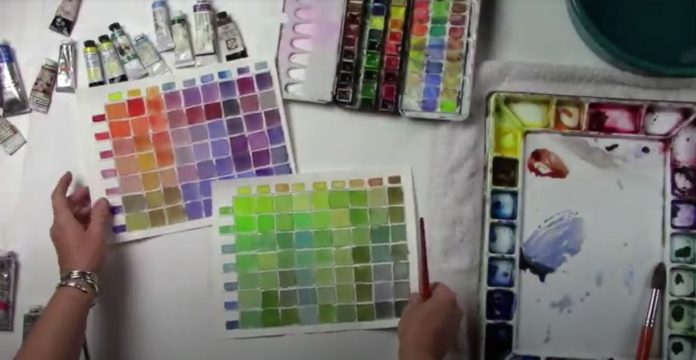
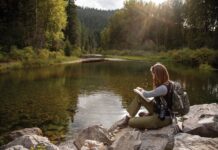
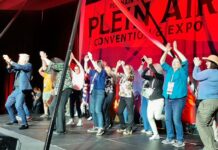
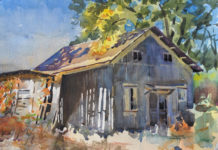




Looks wonderful. ❤️❤️❤️
Dear Eric Rhoads:
I watched your great program for 3 full days, then bought 3 DVDs (Keiko Tanabe Storytelling], Francesco Fontana [The Italian Way], Dan Marshall [Cityscapes]). They are all poor quality and do not work. My tech adviser tells me I should have ordered the streaming version. I paid a lot of money and feel I am entitled to the streaming versions of these three artists’ DVDs. Would you please have your staff send these to me soon as possible. I greatly appreciate it.
Hello, Kathleen! Thank you for joining us at Watercolor Live! I’ve shared your message with our customer service team, and they’ll be reaching out to you soon.